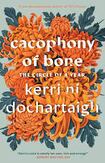
At the beginning of February 2020, as the world trembles on the edge of the pandemic, Kerri ní Dochartaigh pauses in her new Westmeath house and considers time, and moths. White moths have beat their translucent wings against the windows of this isolated house since her arrival from Derry – “that oak-bounded, ghost-bordered city” – in the dead of winter, and she has come to consider these insects as emblematic of the nature and character of time itself.
Time, she sees, does not pass inexorably like sand in a time-glass; moment does not smoothly succeed moment as she has been accustomed to believe. Rather, its motion is fitful and fluttering: “The only way I can put this,” ní Dochartaigh writes, “is to say that time has become erratic, hard to catch – to hold – identify.”
This glimpse into the nature of time is one of many moments of perception caught and shared in this generous, glowing book. Cacophony of Bone is structured as a journal, month by devastating month in a plague year, and its form glances at many additional antecedents.
It is a bestiary: ní Dochartaigh is on intimate terms with the natural world, and hosts of companion animals inhabit the pages of the book; it is a breviary, in its rhythms and familiarity with the sacred character of creation; it is a capacious Pepys-like creation, filled with notes on current affairs and on books read and admired; and it is a book of hours, suffused with awareness of the potency – for good or ill – of each moth-fluttering moment.
READ MORE
For all of this gratifying sense of homage to earlier modes of writing, however, Cacophony of Bone is distinctly innovative in form. In Thin Places (2021), ní Dochartaigh demonstrated keen insights into pain and trauma.
[ Growing up in Derry: ‘We were carrying trauma right into our bones’Opens in new window ]
[ Thin Places: What happens when a child grows up in a city that isn’t safe?Opens in new window ]
This successor book, equally courageous in its exploration of body, mind and the world, is more fragmentary, its prose from time to time breaking and shattering into modes not unlike poetry. This attention to form is a considerable narrative achievement. It mirrors ní Dochartaigh’s distinctly non-linear sense of time – and also persuades the reader to look, assess and imagine afresh.












